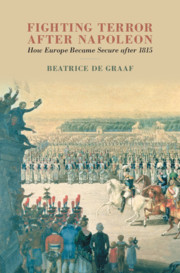Book contents
- Fighting Terror after Napoleon
- Fighting Terror after Napoleon
- Copyright page
- Contents
- Figures
- Maps
- Tables
- Acknowledgements
- Prologue
- 1 Introduction
- 2 Providence in Paris
- 3 Balancing in a Climate of Distress
- 4 ‘A Moderate Occupation’
- 5 Fausses nouvelles and ‘Blacklists’
- 6 Fighting terroristes Together
- 7 The Price of Security
- 8 Fortress Europe
- 9 Beyond Europe
- 10 Conclusion
- Bibliography
- Index
5 - Fausses nouvelles and ‘Blacklists’
The Allied Struggle against ‘Armed Jacobinism’
Published online by Cambridge University Press: 12 September 2020
- Fighting Terror after Napoleon
- Fighting Terror after Napoleon
- Copyright page
- Contents
- Figures
- Maps
- Tables
- Acknowledgements
- Prologue
- 1 Introduction
- 2 Providence in Paris
- 3 Balancing in a Climate of Distress
- 4 ‘A Moderate Occupation’
- 5 Fausses nouvelles and ‘Blacklists’
- 6 Fighting terroristes Together
- 7 The Price of Security
- 8 Fortress Europe
- 9 Beyond Europe
- 10 Conclusion
- Bibliography
- Index
Summary
The system of collective security had a significant bureaucratic dimension to it. The creation of an Allied security agency, the implementation of uniform passport procedures, and the censorship and banishment of persons deemed a threat to the new system of peace and security were met by resistance in occupied France.Hotbeds of radicalization arose, and even Wellington was personally threatened by the rising number of blacklisted persons, terrorists and exiles. The Allied Council had attempted to strike a balance between fighting terror and restoring harmony to post-Napoleonic Europe, but the scope and breadth of the ‘Allied Machine’ was beginning to be questioned. What was the nature and scope of the authority of the Allied Council, and should the ministers become a European police directorate?
Keywords
- Type
- Chapter
- Information
- Fighting Terror after NapoleonHow Europe Became Secure after 1815, pp. 205 - 257Publisher: Cambridge University PressPrint publication year: 2020

